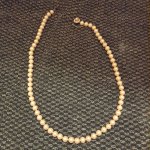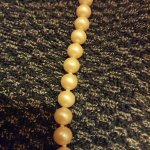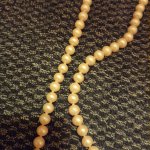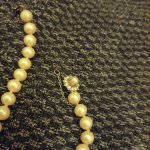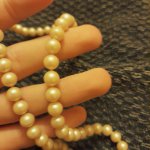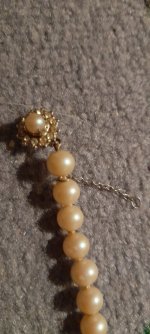Welcome to Pearl Guide!
It is really hard to evaluate pearls that are on a dark background, and even harder if they are not in sharp focus. I see a bit of grime and that makes it hard to evaluate luster.
Please do this: At a minimum, wipe them clean with a damp microfiber cloth. If they have not had a bath in forever, you could swish a bit of mild soap in some water (preferably distilled, if your water is at all hard. We have a well with hard water, and I can't use tap water to clean my pearls-- it will interact with the soap and deposit a terrible, sticky scum on the pearls.) Let the pearls sit in the bath for 15 minutes, rise in more distilled water, and let them dry fully on a soft towel for 24 hours. Wet silk is weakened silk, and the silk inside the drill hole stays wet longer. They should be fully dry before you pick them up again, to avoid stretching the silk and creating gaps.
Then take the photos over using a plain white background. Paper towel is fine. No flash. Please include closeups of any pearls that have flaws (like pits or wrinkles) or any place the nacre seems to be flaking or absent. Check around drill holes in particular. Please include a closeup of the back of the clasp, and tell us if there is any metal mark (585,750,14K, 18K, 925 etc.)
Here are a few simple tests you can do also, after wiping the pearls clean.
1. This is called the "tooth test" but please do NOT use your teeth. Teeth are harder than pearls and can scratch them! Instead, rub one pearl gently against another pearl. Real pearls feel gritty. Imitation pearls will glide smoothly against each other (if clean; if grimy they may stick a bit.)
2. Temperature test. Real pearls feel cooler than fake pearls. To test this you will need some other pearls to compare with (whether pearls you know are real or that you know are fake. Earrings are fine.) Put them both in the same temperature environment for half an hour or so, to eliminate that variable. Then test by holding the pearls briefly to your lips, which are very temperature-sensitive.
3. Loupe test. Do you have a 10x jeweler's loupe? Real nacre looks very smooth under 10x magnification (but choose a spot without a flaw to examine, of course). Fake pearls, even very good ones, have a slightly coarse texture, visible under 10x power (but the cheaper the fake pearls, the more coarse they will look). Again, it will help to have some other pearls to compare with. If you don't have a loupe, you could visit a jeweler and ask if you can use their loupe to have a look at your pearls, and also look at pearls they are selling for comparison.
4. Although I have some fake pearls with a karat gold clasp, most fakes will have either a base metal, silver, gold plated, gold filled or vermeil clasp. If you find they have a karat gold clasp, you might want to take them to a jeweler to see if the stones are diamonds. Obviously that would argue in favor of the pearls being real cultured pearls. (But clasps can be changed when pearls are restrung, so even that is not definitive.)
5. Fake strands may have no blemishes but real strands usually have at least a few.
Now my gut reaction at seeing the photos: I suspect they are imitations. For many reasons. The uniformity of their size, color, surface, and luster in particular (low luster). But that could be because of grime. So do clean them! And then test, or post again.

